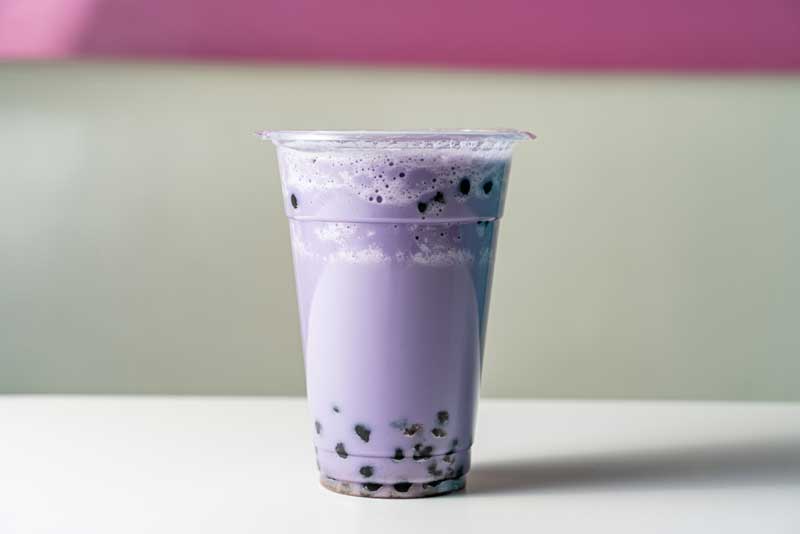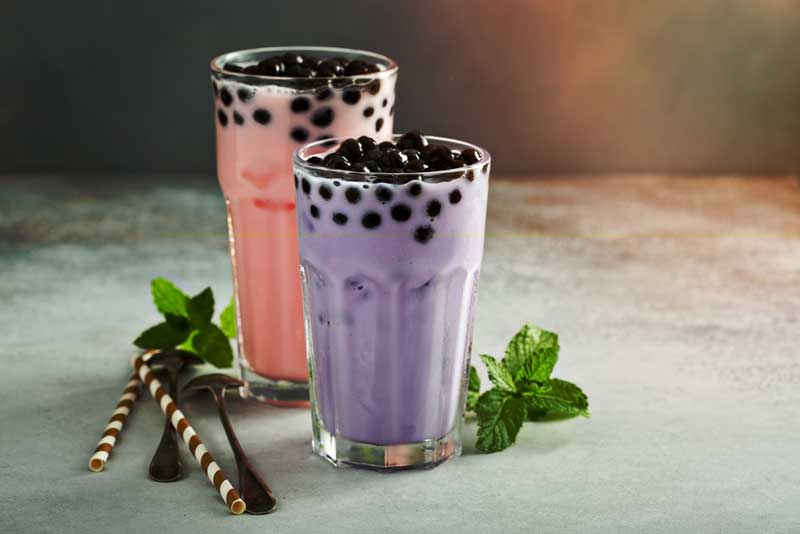You might be fond of taro tea, and you’re probably wondering if it packs caffeine. You don’t want to toss and turn all night after having a drink, right?
Whatever your curiosity is, you’d want to know too if taro gives you that caffeine kick without the jitters.
So does taro have caffeine? There are different kinds of taro tea which means the caffeine content can vary significantly.
However, the more common taro milk tea does not contain caffeine.
Do you want to know more about taro and its caffeine content? Do read on!
Taro: An Overview
In African and South Asian cuisines, Taro is a prevalent dietary staple. It has a subtle sweetness to it and a starchy nature. Thriving in different parts of Asia, especially the subtropics, the taro has earned the name “the potato of the tropics.’
Peel back its coarse, brown exterior, and you’ll find that Taro varies in color, from beige to light purple, to soft pink, contingent upon its place of cultivation. If you want fresh taro root, hit up any Asian market.
What is Taro Tea?
Taro tea has its roots in Taiwan and has become a trendy drink mainly because of its distinctive taste and visually enticing purple hue. It’s a fun version of regular milk tea, made with milk, brewed tea, and sugar.
The inclusion of taro in taro tea gives it its special character. You can find taro all over Southeast Asia, Pacific Islands, and Africa. Taro provides the tea with a defining element and tastes you can barely see in another tea.
Taro tea is characterized by a smooth, sweet, slightly nutty taste many appreciate. It’s also the ultimate go-to drink, in terms of being aesthetically pleasing, to show off on social media!
An interesting tidbit is that taro tea doesn’t even include natural tea. Shocker right? Taro has various condiments incorporated into its preparation, but it is devoid of tea.
Once you cook the taro, mash it, or turn it into powder, mix it with sweetener, hot tea, or milk. The drink turns out to be creamy and slightly nutty with hints of vanilla.
And that gorgeous purple color? Well, it comes naturally from certain taro types or adding some food coloring when using processed taro powders.
Here’s another remarkable fact: The founder of Bubbleology and ex-British investment banker, Assad Khan, had his first-ever boba experience with taro bubble tea in New York.
That encounter motivated him to start his own boba tea company, which has since grown into one of the UK’s largest bubble tea brands.
Also Read: Does Honey Mustard Have Dairy? (Answered) and Is Cinnamon Toast Crunch Vegan? (Everything to Know)
Does Taro have Caffeine?
Taro and caffeine, what’s the tea?
You’ll find lots of different versions of taro tea, and that means the caffeine content can vary significantly.
The classic taro milk tea is made like a smoothie with herbs and sweeteners, and it’s caffeine-free. People often use it more for its medicinal benefits than a regular drink.
But that doesn’t imply that taro root is only about being healthy! It’s super tasty and perfect for enjoying just for fun!
Now the question, “Does taro have caffeine?” comes to mind. When you boil and blend taro root, it bursts with beautiful flavors. Being starchy, it easily absorbs any added flavor, creating a foundation for numerous health benefits.
The versions of this drink that are mixed with green tea or black tea leaves are the most caffeine-laden. If you want that extra caffeine kick, go for the versions that have black or green leaves in them.
Typically, taro tea that has few tea leaves in them provides up to 30 milligrams of caffeine. And this is just one because you can get more with more potent blends.
Another cool thing is using some black tea leaves to make taro milk. That way, you’ll get a different color and a pleasant aftertaste.
For a personalized and powerful kick, try mixing and matching black tea and green tea leaves. That combo will keep you super active, even long into the night!
What Is Used in Making Taro Tea?
We might’ve cleared your curiosity on the ‘Does taro have caffeine?” question, but now you want to know what else it is made of.
You prepare taro tea with taro root, black tea, condensed milk, milk, and tapioca pearls. It’s a super refreshing Boba tea, packed with many flavors.
You can find some fantastic purple versions of taro milk tea in many Boba tea shops! They add fun stuff and toppings to make it even more exciting.
What Does Taro Taste Like?
The real taro tastes potato-like and reminds you of buttered popcorn-flavored jelly beans.
When you make milk tea with real taro, add some sweetener, and you’ll get a super tasty buttered popcorn taste. And even if you use powdered taro, the milk tea will still be a yummy mix of creamy caramel flavors.
Unless you’ve experienced root-like taro before, it’s hard to envision how all its diverse flavors come together in taro tea. But that’s precisely what makes it a sought-after delight at boba shops.
What Are The Health Benefits Of Taro?
You’re probably a big fan of taro tea and enjoy drinking it often. It’s one of your favorite drinks, and sometimes you might wonder if it’s good for you.
Well, it may not give you so much of a caffeine jolt but don’t underestimate taro’s nutritional goodness. Let us tell you all about them!

1. Vitamins and Minerals
Taro contains vitamins and minerals that work wonders for your overall well-being. One of its main components is vitamin C. This antioxidant boosts your immune system and keeps your skin glowing through collagen production.
You will also find that taro is rich in potassium, which regulates blood pressure and facilitates the proper functioning of the heart and muscles. And that’s not all! Taro delivers a good dose of magnesium that keeps your nerves in top shape and helps produce energy.
2. Antioxidants
It’s a good idea to incorporate taro into your diet for a healthier you because it has oxidants like flavonoids and polyphenols that do well to safeguard the body against harmful illnesses.
Eating taro may lower the risk of chronic diseases, including neurodegenerative disorders.
3. Low in Fat and Calories
Taro is a fantastic addition to any balanced diet, as it is low in fat and calories. If you want to manage or shed some weight, taro can be a satisfying, guilt-free choice.
4. Dietary Fiber
Dietary fiber plays a crucial role in maintaining a well and working digestive system, and the fiber taro provides helps with constipation, allowing for free bowel movements.
Not only that, but getting enough fiber in your diet can also help manage your weight and reduce the risk of chronic conditions such as diabetes. So adding taro to your meals is a bright, healthy choice.
5. Allergen-Free
As a root vegetable, taro is usually free from common allergens. It is a safe option for people with adverse reactions and hypersensitivities.
Also Checkout: Is Red Bull Vegan? (Everything To Know) and Do Sour Patch Kids Have Gelatin? (Answered)
Frequently Asked Questions-Does Taro Have Caffeine
What Is Taro Made Of?
Taro is originally from Southeast Asia and is a starchy root vegetable cultivated to add some life to African, Asian, Caribbean, and Pacific Islander cuisines. People love cooking the root for bubble tea, and the leaves are medicinal.
Does Taro Boba Contain Caffeine?
Yes, it does! This tea contains caffeine when you make it with green or black tea, as both these teas naturally have caffeine in them. But if you want to steer clear of caffeine, you can simply go for a caffeine-free version of taro boba.
What Is the Difference Between Taro Milk Tea and Milk Tea?
Taro milk tea and milk tea can be distinguished effortlessly. You know the boba, those chewy tapioca pearls? Milk tea often comes with them, and that’s what makes it “bubble tea.”
But taro milk tea has a slightly sweet flavor that even goes well with milk tea. All you do to make it is add some taro root, either ground up or as an instant powder, into your regular milk tea base.
What Does Taro Milk Tea Taste Like?
Taro milk tea is naturally sweet and has a delightful hint of vanilla, coupled with a touch of nuttiness. Besides its incredible taste, the drink’s purple hue adds to its charm, making it delicious and visually appealing.
What Toppings Go Well With Taro Tea?
Taro tea is fantastic because it pairs well with so many toppings! You can enjoy it with classic choices like crystal boba, grass jelly, or tapioca pearls.
However, it is also surprisingly delicious with toppings such as red beans and sago!
What Fruit Goes With Taro?
Taro and coconut make a winning combination. It’s incredible how versatile taro is and goes beyond the “Does taro have caffeine?” question, offering numerous culinary experiences.
When it is mixed with simple items like yogurt, it gives it a whole new flavor profile. And when you mix taro into sweet treats like pudding, it tones down the sweetness a bit and adds a lovely texture.
Conclusion-Does Taro Have Caffeine
Taro tea is a tasty, nutritious drink to include in your diet! Does taro have caffeine? It does, only if it’s mixed with jasmine tea or with green tea.
But if you’re off the caffeine train and want a caffeine-free option to replace your regular tea or coffee, give taro a shot.

